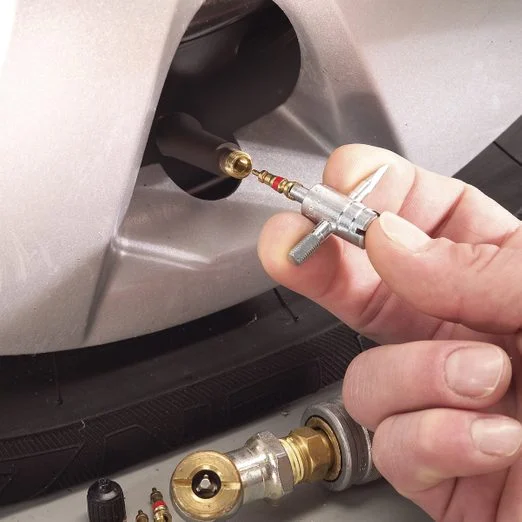What is a Valve Stem?
A valve stem is a small valve found on all vehicle tires that allows air to enter or escape the tire. It is a critical component that enables proper tire inflation and maintenance.
The valve stem consists of a valve core, valve stem body, valve cap, and rubber gasket. The valve core is a small threaded shaft with a spring-loaded pin inside. When the pin is depressed, it allows air to flow through the valve. The valve stem body is a metal or rubber tube that houses the valve core and connects it to the wheel rim. The valve cap screws onto the end of the stem body and helps keep out dirt and moisture. The rubber gasket provides a seal between the stem and wheel rim.
The main purpose of a valve stem is to enable tire inflation. By removing the valve cap and depressing the valve core pin with an air chuck, pressurized air can flow from an air compressor or pump into the tire’s inner chamber. This increases air pressure inside the tire. The valve stem also allows controlled air release from the tire by pressing on the valve core pin with a slender object like a tire pressure gauge. This is how tire pressure is checked and lowered if needed. Overall, the valve stem acts as the tire’s air passageway, enabling inflation maintenance and pressure adjustments.
Table of Contents
Common Causes of Leaking Valve Stems
Valve stems can start leaking for a few common reasons:
Age
Valve stems are made of rubber and like any rubber component on a vehicle, they degrade over time. The constant heating and cooling cycles, exposure to the elements, and general wear and tear can cause valve stems to become brittle and develop cracks or holes, allowing air to leak out. Old and worn valve stems are a common cause of leaks.
Looseness
The valve stem nut should be tightened to a specific torque to ensure a proper seal. If the nut becomes loose due to vibrations or not being tightened sufficiently, it can allow the valve stem to move and wobble inside the rim hole, disrupting the seal and causing leaks. Periodically checking torque on the valve stem nut can help avoid looseness issues.
Corrosion
Steel valve stems can become corroded over time, especially in areas where roads are salted in winter. The corrosion roughens the surface of the stem, preventing a tight seal against the rubber grommet inside the rim. Corrosion buildup needs to be cleaned off to restore a smooth sealing surface.
Damage
Direct impacts to the valve stem from curbs or debris can crack, bend, or shear off the stem, resulting in catastrophic air loss. Lower profile valve stems are more vulnerable to such damage. Careful driving and avoiding curbs can help prevent damage-related leaks.
Signs of a Leaking Valve Stem
A leaking valve stem can be detected through several telltale signs. Being aware of these signs allows you to address the issue promptly before it causes further problems.
Hissing Sound
One of the most common indicators of a leaking valve stem is a hissing sound coming from the tire when it is filled with air. This sound occurs because air is escaping through the loose connection between the valve stem and wheel rim. The intensity of the hissing often increases as more air pressure builds up inside the tire. So if you hear an audible hissing noise near the valve stem, that’s a sure sign it needs to be repaired or replaced.
Flat Tire
If you find one or more of your tires constantly going flat, a leaking valve stem may be allowing air to seep out. This can happen slowly over time or more rapidly depending on the extent of the leak. Sometimes a loose valve stem connection is obvious if you can see the tire visibly deflating. Check around the valve stem for any air bubbles as described below.
Air Bubbles
Closely inspect the valve stem and surrounding area for air bubbles after inflating the tire. Air will leak through the gap and create bubbles if the valve stem is not properly sealed against the wheel rim. The bubbles signify it is not making an airtight connection. Watch the valve stem and sidewall area while adding air and note any bubble formation.
Dangers of Driving with a Leaking Valve Stem
Driving with a leaking valve stem can be extremely unsafe and dangerous. The main risk is a potential tire blowout, which can cause you to lose control of your vehicle.
When air is leaking from a valve stem, the tire is continuously losing pressure. Over time, this will cause the tire to become severely underinflated. An underinflated tire has reduced stability and traction on the road. The tread wears unevenly, handling is compromised, and the sidewalls are more prone to overheating.
If the leak is left unaddressed, the tire will eventually deflate completely. When this happens while driving at high speeds, it can easily cause a blowout as the underinflated sidewall gives out under the weight and motion of the vehicle.
A blowout is an extremely dangerous situation where the driver can lose control of the steering and braking. This often leads to accidents, especially if it occurs on the highway. The sudden lack of traction on one corner of the vehicle makes it very hard to maintain control.
Even a relatively minor leak should be addressed immediately to avoid the risks of a blowout. Never ignore signs of underinflation or a valve stem leak. The dangers are simply too great, especially at high speeds. Always pull over and inspect your tires if you suspect even a small leak. Driving any further risks a catastrophic loss of control.
How to Check for a Leaking Valve Stem
There are a few methods to check for a leaking valve stem:
Visual Inspection
Look closely at the valve stem and surrounding area for any signs of dampness or grease. A leak may leave behind a wet spot or stain. Check where the valve stem meets the rim for moisture or oil residue.
Soapy Water Test
Mix a solution of dish soap and water in a spray bottle. Spray or brush the soapy water directly onto the valve stem and surrounding rim. Watch carefully for bubbles forming, which indicate air escaping through a leak. The soapy water helps amplify and pinpoint the exact location of the leak.
Listen for Hissing
If you hear any hissing sound around the valve stem area, especially when the tire has been filled with air, that points to a leak. The hissing noise is the air escaping through the faulty valve seal. Go around the tire and listen closely near the valve stem on both sides of the wheel to detect where the hissing is coming from.
How to Fix a Leaking Valve Stem
The most common fix for a leaking valve stem is to simply tighten it. The metal stem threads into the rim of the wheel to hold the valve in place. Over time, vibrations from driving can cause it to loosen. Use a valve stem tool or small pair of pliers to turn the valve stem clockwise and tighten it back up. Tightening it just an extra quarter turn is often enough to stop a slow leak.
If tightening doesn’t work, the rubber gasket inside the valve stem is likely worn out. Replace this gasket to stop the leak. Begin by deflating the tire and removing the valve stem cap. Use the valve stem tool to unthread and remove the entire stem. Inspect the rubber gasket on the underside of the stem and replace it if cracked or damaged. A replacement rubber gasket can be purchased at any auto parts store for a couple dollars. Insert the new gasket into the valve stem, then reinstall the stem by threading it back into the wheel. Tighten it securely before re-inflacing the tire.
If the valve stem itself is damaged or broken, the entire stem will need replacement. This involves the same process of removing the old stem, then installing a new one and tightening it properly to stop any leaks. New valve stems can be bought affordably at parts stores. Make sure to get the proper type and length for your vehicle.
When to Call a Mechanic
While fixing a leaking valve stem is often a straightforward DIY repair, there are times when it’s best to call a professional mechanic. If you’ve attempted to fix the leak yourself and it persists, take it to the shop. A stubborn leak likely indicates a deeper issue that requires specialized tools and expertise to properly diagnose and repair.
Specifically, call a mechanic right away if:
- The leak doesn’t stop after replacing the valve stem core and rubber gasket seal. This points to a problem with the valve stem itself or the wheel assembly.
- The leak is rapid and you cannot safely drive the vehicle. A major leak could indicate a serious underlying issue. Don’t risk driving in an unsafe condition.
- You don’t have the proper equipment or expertise for the repair. Replacing a valve stem requires some mechanical skill. If you are not comfortable doing it yourself, have a professional handle it.
- The valve stem is damaged or faulty. If the valve stem itself is cracked, bent, or otherwise compromised, it must be replaced. This requires tires to be dismounted and is best left to professionals.
- There are other concerning symptoms along with the leak. Issues like vibrations, handling problems, or noises point to suspension, alignment or balance problems.
When in doubt, call a trusted mechanic. For safety, some repairs are best left to those with the skills, tools and experience to diagnose and fix them properly. If your DIY efforts don’t solve the leaking valve stem, have a professional inspect it before driving the vehicle again.
Valve Stem Maintenance
Proper maintenance is crucial to prevent valve stem leaks. Here are some tips:
Check valve stems regularly – At least every oil change or twice a year, do a visual inspection of the valve stems. Look for any cracks, corrosion, missing caps, or wetness that could indicate a leak. Spin the cap to ensure it is tight.
Avoid damage to valve stems – Be gentle when installing tire pressure caps. Over tightening can damage the valve stem. Also take care not to bend stems when changing tires or rotating wheels. Use the proper tools and techniques.
Use high quality replacement parts – If a valve stem is cracked or damaged, replace it promptly with a high quality part. Choose solid brass or nickel plated stems with quality rubber seals. Avoid cheap plastic stems that can crack. Investing in quality parts now prevents bigger problems down the road.
Keep valve stems properly lubricated – Lightly lubricate the valve stem with oil when rotating tires or doing other maintenance. This prevents drying out and corrosion. But don’t over lubricate as this attracts dirt.
Check TPMS seals – If your vehicle has Tire Pressure Monitoring System (TPMS) sensors, check that the rubber grommet seals around the valve stem are intact. Cracked or missing seals can allow air leaks. Replace damaged seals promptly.
With proper care and maintenance, valve stems can last the life of your tires. But neglect can lead to annoying and dangerous air leaks. Invest a few minutes in regular valve stem checks and maintenance to prevent problems down the road. Quality parts and careful handling go a long way.
Valve Stem Types
There are several common types of valve stems in vehicles today:
Standard Valve Stems
The most common type of valve stem is the standard rubber valve stem. These valve stems consist of a metal valve surrounded by rubber tubing. The rubber provides a seal against the wheel rim while allowing the valve to be accessible from outside the tire. Standard valve stems are susceptible to dry rot and cracking over time, which can lead to air leaks.
Rubber Gasket Valve Stems
Rubber gasket valve stems aim to improve on the standard design. They incorporate an internal rubber gasket to provide a tighter seal against the wheel rim. The rubber gasket helps prevent leaks that can occur when the metal valve stem doesn’t sit perfectly flush against the rim.
Metal Clamp-In Valve Stems
Metal clamp-in valve stems feature an all-metal construction and a gasket that clamps against the interior of the wheel rim. This creates a very robust seal that is less prone to leaking. Clamp-in valve stems are common on commercial trucks and other heavy-duty vehicles.
Tire Sensor Valve Stems
Many modern vehicles use tire sensor valve stems that contain sensors to monitor tire pressure. These valve stems connect to the vehicle’s tire pressure monitoring system to provide real-time pressure readings. If the pressure drops, the sensor transmits a signal to trigger a warning light on the dashboard.
Valve Stem Safety Best Practices
Proper valve stem installation and regular maintenance are crucial for safety. Here are some best practices:
- Use high quality valve stem parts from reputable manufacturers. Avoid cheap or used valve stems, as they are more prone to leaks and failure. The small savings aren’t worth the risk.
- Make sure the valve stem is installed correctly at the proper torque specs. Over or under tightening can lead to seal failure and air leaks. Consult your owner’s manual for the proper installation procedure.
- Periodically check valve stems for cracks, corrosion, looseness, or other damage. A visual inspection takes just a minute. Replace any valve stems that show wear.
- Listen for air leaks when filling your tires. If you hear air hissing from the valve stem, that’s a red flag. Replace leaking valve stem seals or the entire stem.
- Make sure valve stem caps are always installed. The cap keeps out dirt and moisture that can damage the valve internals.
- Consider upgrading to high quality metal valve stems. They are more durable than rubber valve stems and less prone to cracking. The slight extra cost is worth it.
- When installing new tires, take the opportunity to inspect and replace valve stems if needed. It’s easier with the tire off.
Following proper valve stem practices reduces the chances of dangerous air leaks or blowouts on the road. Take a few minutes for valve stem safety.



